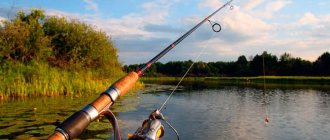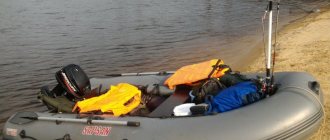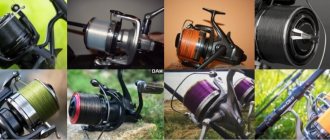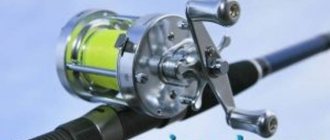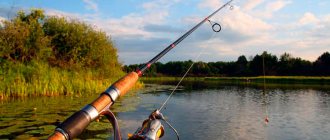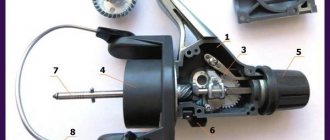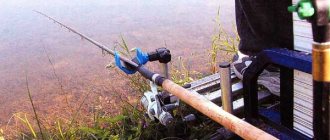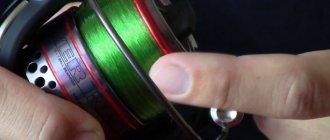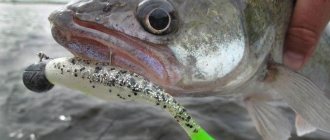- rod
2
- fishing line
3
- float
4
- sinker
5
- hook
Float rod
- one of the simplest fishing gear, which led to its widespread distribution. A float fishing rod consists of a rod, a fishing line attached to it with a float, a sinker and a hook with bait. Using a rod, the bait is thrown into the water. The behavior of the float (bite) determines the moment when the fish holds the bait in its mouth. When biting, a hook is made - a small sharp movement with the rod. The hooked fish are fished ashore.
In recreational fishing, the float rod can be of any type - from a whip cut from the forest to a modern ultra-light rod, both with and without rings. Rods without rings, being the lightest, are used in sport fishing.
The length of the float rod can range from ten centimeters to 18 meters. Its length depends on how far the fishing point is from the angler. When using a rod without guides, the length of the fishing line is approximately equal to the length of the rod, so the bait can only be cast over a distance not exceeding twice the length of the rod. If the length of the fishing line exceeds the length of the rod, then casting becomes impossible, and when fishing for fish it is difficult to bring it close to the shore. With a short line, landing fish becomes difficult.
The exception is an extra-long rod, the so-called “plug”. When fishing with a plug, the length of the fishing line is much shorter than the rod and is not much greater than the depth at the fishing site. When casting a bait with a plug (it would be more correct to say delivery), the plug is assembled, and when fishing, it is disassembled.
Increasing the casting range of the nozzle up to 100 meters is possible using a rod with rings equipped with a reel. The reel on the rod also makes it easier to land large fish.
All fishing rods usually require balancing. Rods without rings are balanced by placing a balancing weight in the butt. Balancing a fishing rod with rings is carried out by selecting a reel of the appropriate weight, and placing it as close to the butt as possible.
Any commercially produced fishing line can be used with a float rod; in some cases, strong threads can be used.
Content
- 1 Float rod equipment
- 2 Methods of fishing with a float rod 2.1 Fishing with a sliding float
- 2.2 Fishing from the bottom
- 2.3 Fishing with a float and a weight
- 2.4 Fishing with a flip
- 2.5 Fishing with wire
- 2.6 Swim fishing
- 2.7 Fishing with a slowly sinking bait
- 2.8 Winter fishing with a float
Float rod equipment
- Coil.
For fishing with a fishing rod, you can use an open inertia-free reel, the same as when fishing with a spinning rod. There is no need to purchase special coils.
- Fishing line.
Most recreational fishermen use line made of synthetic fibers (reinforced). It is very durable, does not rot and is hardly noticeable in water. For a float fishing rod, the thinnest fishing line is used - from 0.15 to 0.3 mm, which is quite enough for landing large fish.
- Sinker.
It makes it possible to fish at a wide variety of depths by adjusting the release of the line with the nozzle by moving the float through the line. The sinker must match the buoyancy of the float, sinking it by two-thirds. A float lying flat on the water indicates a completely insufficient weight of the sinker. The goose signals this especially clearly. This position of the float on the water reduces its sensitivity to bites. In addition, we can assume that it is shallow here and the bait lies on the bottom.
- Hook.
Fishing success often depends on the quality and correct choice of hook. The size of the hook must correspond to the size of the fish being caught, as well as the size of its mouth and bait.
General structure of the gear and the influence of individual components on casting
Spinning tackle consists of the rod itself, a spinning or multiplier reel, cord or fishing line and bait. Each of the components is capable of influencing both technique, accuracy and casting range to varying degrees.
Spinning . Fishing rods differ in action, length, material and test. The distance of the throw is greatly influenced by the length of the form. The longer the rod, the further the spinning rod will be cast, however, it should be taken into account that the technique will also be somewhat different. Short rods are often good for casting with one hand, but long rods need to be cast with both. Accuracy and range are also affected by formation. Fast and ultra-fast action forms are generally believed to provide greater bait flight range and accuracy; slow rods are somewhat inferior in this regard.
This is interesting: Cooking while camping
Reel _ How to cast a spinning rod correctly is largely influenced by the type of reel - casting with a spinning reel and a multiplier reel is significantly different. How to properly hold a spinning rod with different reels when casting? For inertia-free, the standard option is that the coil and rings are directed downward, the leg of the coil passes between the third and fourth fingers of the working hand. In the case of multipliers, it’s the other way around - both the rod rings and the reel itself are directed upward, and the cast itself is less sharp; when casting with a multiplier, smooth acceleration is important.
The diameter of the cord or fishing line primarily affects the casting distance. In the vast majority of cases, the appropriate diameter (or breaking load) will be indicated directly on the form. Fishing with thicker lines can significantly reduce the casting distance of the bait.
Weight of bait . Everything is quite simple here. It is strongly not recommended to go beyond the test values indicated on the spinning rod (although experienced anglers who know the capabilities of their rod sometimes throw heavier baits). Depending on the spinning rod model and manufacturer, the casting range can be maximum either when using baits closer to the upper limit of the test, or closer to the middle.
Methods of fishing with a float rod
Fishing with a sliding float
When fishing it is necessary to cast the bait far, a sliding float is used. It is advisable to fish with it at great depths (5-7 m) from a boat, rafts, dams and from the shore, when you need a long cast to depth or to a place free from thickets. A sliding float is also used when fishing for predatory fish with live bait. Before fishing, the depth of the place where they are going to fish is established, and, having secured the upper stop on the fishing line, the float is moved to the lower stop-sinker. Having grabbed the fishing line above the float, make a smooth cast forward and upward so that when it falls on the water, the bait does not fall off the hook. When fishing with a reel and a supply of fishing line, there is no jerk. When fishing without a reel, the required length of fishing line is wound from the reel of the rod, laid out in circles on the shore (preferably on thick fabric) or collected (also in circles) on the fingers of the left hand holding the rod. With your right hand you cast the bait and at the moment it falls on the water, move the rod forward, thereby eliminating the possibility of a jerk. The same is done when fishing from a boat. But a long fishing line creates difficulties when landing hooked fish. It is easier to catch fish with a rod and reel, which, as a rule, is used when fishing at great depths only with a small and soft stop-limiter for the float, which freely passes through the rings of the rod.
Fishing from the bottom
Fishing from the bottom The same tackle, but with an increase in the length of the float release, can also be used when fishing from the bottom. Then the sinker hanging on the fishing line almost touches the bottom, the hook with the nozzle lies on the bottom, and the float is in a semi-submerged position. This setting is very sensitive and allows you to notice the slightest touch of the fish. This method gives successful results when fishing for fish that take bait from the bottom in places with strong soil. However, when a wave throws up and down the float, it is less effective, since the sinker and nozzle twitch all the time and scare away cautious fish. In these cases, the float is moved 75-100 cm higher, a long cast is made and the sinker and bait are allowed to lie on the bottom. Although with this setup of the gear the sensitivity of the float is significantly reduced, the energetic bite of the fish is noticeable. You can also fish with a float raised from the water and hanging in the air on a fishing line 30 cm from the tip of the rod (closer to the surface of the water if possible). In these fishing options, it is necessary to make the sinker heavier and replace it with a heavier and sliding one. The method of fishing from the bottom on rivers in early spring, before the water clears and after heavy rains has clouded it, is successfully used, when the fish does not notice the floating bait well, looking for food at the bottom or closer to the banks, where the current is also quieter. There is no need for long-distance casting of the bait. The sinker is placed sliding or on a separate leash, the float is 100 cm from the tip of the rod. After casting, the rod is brought forward, the sinker and bait are allowed to lie on the bottom, and the float is lowered into the water along a stretched fishing line not far from the shore, in a place with a quieter current. It is better to throw the bait downstream at an angle of 45 degrees, which reduces the number of snags.
Fishing with a float and a weight
When fishing for insects from the surface of the water, sometimes long casts are also necessary. They are made with a spinning rod with a reel and a float-weight, which is attached to a fishing line 60-100 cm from the hook. Bulk and heavy floats make casting easier, but when they fall on the water they give a strong splash and scare away the fish. The usual weight of a float-weight is 15-30 g, and when using a spinning reel it is half as much, the fishing line is at least 50 m long, about 0.3 mm thick, with a leash of 0.2-0.25 mm. The greater the distance between the float and the hook, the more successful the fishing, but the more difficult the casting. In order for the cast to be successful, you need to delay the flight of the float before it falls into the water. This technique, with simultaneous feeding of the rod forward, ensures a smooth fall of the bait in front of the float when the line is extended. If necessary, you can also fish with a sinking bait by placing a small sinker on the line 15 - 20 cm from the hook, which makes casting easier. They catch with a float-weight in shallow water overgrown with water, as well as on the main stream of the current from spring to autumn - chub, ide, asp, grayling, dace, dragonfly, beetle, gadfly, grasshopper, butterfly, bumblebee, fly, caterpillar, small little frog.
Fishing in the toss
This method is used to fish from a slowly moving boat, going downstream or rowing with a stern oar against the current. The boat is directed along the shore, and the bait is thrown under tree branches hanging over the water, to aquatic vegetation, to clean places among the thickets, to banks with washouts, and half-submerged trees. You can fish with the bait from the shore and in the wade. They fish with a light 8-5 meter fly fishing rod. The line is taken with a thickness of 0.4 mm and a length equal to the length of the rod, which increases the casting accuracy and allows you to make side casts with the nozzle placed under branches hanging over the water. A short (40 cm) leash 0.2 mm thick is attached to the fishing line. It is necessary, since with this fishing method it is difficult to avoid getting caught on branches or grass. The float is usually small, oblong, made of burnt cork. Attach it to a fishing line near the leash. When fishing for chub or ide in the evening, it is advisable to equip the float with a small tee, since the fish often grabs the float when it falls on the water, mistaking it for a fallen beetle. The size of the hook depends on the type and size of the bait. As a rule, No. 6 - 7 with a straight bend and a short forearm, which can be replaced with a double or tee soldered from hooks No. 4 - 5. It is good to use a light wire reel when fishing in the bait. The bait includes grasshoppers, gadflies, beetles, evening butterflies, caterpillars, small frogs, worms, caddis flies and maggots.
Fishing in the wire
Wire fishing You can fish with wire from the shore, boats, rafts, bridges, piers - where there is a slight current.
One of the conditions for fishing is the correct choice of place with an approximate depth of 1.5 to 6 m, the same for 6-8 m downstream, and an uncluttered, flat bottom. Fishing from the shore is also possible in places with shallower depth. The fisherman must camouflage himself in the coastal vegetation. Another condition is the use of bait that floats with the flow and attracts fish to the fishing site. In the wiring they catch ide, bream, chub, bassfish, barbel, silver bream, roach, dace, and perch. A fish bite can also occur during test swims of the bait. It is recommended for a novice angler to make a short hook when holding or submerging the float. The rod should be held parallel to the surface of the water and the hook should be done against the current. In this position, the float and the nozzle move less towards the shore than when hooking towards itself. Fish are fed differently when fishing from the shore. Having scattered the bait and prepared the tackle, after a short break (10-15 minutes) they begin fishing. The cast is made upstream so that the bait floats along the stream, which washes away the food. The higher upstream the float and bait are thrown, the closer to the shore they will float. The best is a side cast. After casting, when the float takes a vertical position, by moving the rod tip towards you and upward, the slack of the fishing line from the tip to the float is eliminated and during the further passage of the float, carefully monitor this and, if necessary, move the rod tip against the current. So, lightly holding the float, let it float downstream for the entire length of the fishing line released from the rod. At the end of the swim, the float (and, consequently, the bait) approaches the shore. Running the float on a light line allows the angler to strike immediately the first time the float is held or submerged. Usually the bait is placed near the bottom, sometimes slightly higher, and even halfway (for example, when fishing for greens). In some cases, good results are achieved by moving the bait along the bottom - the so-called fishing “with a wire”. This is only possible if the bottom is level and the bait is held firmly on the hook. Having used one cast completely, make a new one, and this continues throughout the entire fishing period. In this case, the rod has to be held suspended for a long time; this tires the hand, especially if the rod is long and not balanced enough. To reduce the load on the hand, you need to grab the butt with your hand and rest the butt end under the forearm, about halfway there. It is advisable to use reel gear for fishing from the shore if it is necessary to release the fishing line downstream from you (when fishing in a wade, from a cape protruding far into the river). Successful fishing from a boat. It is easier to find a good place for fishing at any distance from the shore, and there are more opportunities to attract fish with bait.
Swim fishing
This method is used to fish on riffles in a wade or from a boat, allowing the bait to float with the current; in the waters - launching the nozzle along the ripple stream from the shore; from the dam - on the stream bordering the calm water. On rivers, the boundaries of aquatic vegetation, places with branches hanging over the water, and near sunken trees are fished. The best bite is in the evening. Most often, dace, roach, chubs and ides are caught on gadflies, grasshoppers, bark beetle larvae, caddis flies, worms, maggots, omentum, May and June beetles, steamed peas, grains of wheat or oats. As a rule, larger fish take baits when released farther. In this case, they use a fishing rod 3 m long with an elastic tip 3-4 mm thick, equipped with a light wire reel, fishing line with a diameter of 0.3 mm and a leash (75-150 cm) made of fishing line 0.2 mm thick, painted to match the color of the water. The hook and float are the same as for casting fishing; their sizes increase significantly if pike perch or asp are caught with live bait from a dam in a fast current, usually using a spinning rod. The release of the float when fishing by swimming is different, and depends on the depth of the bait, the strength of the current, and the fishing technique (floating on the surface or sinking bait). If the current is strong, the float is attached 150 cm from the hook. The nozzle should float ahead of the float. A fish bite is marked by immersing the float or moving it to the side. In all cases, you need to do an energetic hooking. Swimming is sporty, easy to learn and successful.
Fishing with a slowly sinking bait
In the summer months, fishing with a slowly sinking bait can be successful. This method is used to catch roach, rudd, crucian carp, chub, ide, dace, silver bream, small bream and other fish in reservoirs without a current or with a slow current, mainly during the period when a large number of flying insects appear. Sinking bait becomes food for many fish. The gear for this fishing consists of a flexible rod 3-4 m long for smooth casting of a light bait; thin fishing line, painted green or bluish, 1 m (no more) exceeding the length of the rod; small hook with a short shank; a small float made of cork or polystyrene foam without a bright color. When fishing among aquatic vegetation, a small release of the float is enough, and in deep places it is increased so that the nozzle can smoothly sink to the bottom with the line extended straight. Some baits, such as grasshoppers, cockroaches, flies, can float on the surface of the water for some time when they fall. To make casting easier and speed up the sinking of such a bait, you can pre-wet it or fish with a small shot attached to the end of the hook. A fish bite is marked by a slight pull on the float, which is responded to with a short hook. If there is no bite when diving the bait, you need to let the bait sink to the bottom, and then move it a little with a short movement of the rod. When fishing this way, the fisherman must mask and periodically throw the bait in small portions. A variety of baits are used: grasshopper, fly, cockroach, small caterpillar, piece of dung worm, maggot, bark beetle larva, bloodworms, steamed grains of wheat, small peas, rye, oats, barley, dough, pearl barley, bread crumb, etc. The fish takes small bait more willingly and more decisively. The best places for fishing on a slowly sinking bait are under tree branches hanging over the water, near aquatic vegetation, clear places (windows) among it, the mouths of streams flowing into into a body of water, especially after rain. Fishing in a wade in the shallows with casting the bait into the depths is invariably successful. It is better to fish from a boat in the coastal zone near aquatic vegetation or near the transition of the shallows into the depths. This method is used to fish with one rod, often changing fishing spots.
Winter fishing with a float
Winter fishing with a float In winter, many river and lake fish are caught using natural bait. Fishing rods for ice fishing are mostly made with handles that are convenient for placing them on the ice. Wooden legs are attached to turned or cork handles. Previously, a “block” or “filly”, as fishermen call it, was cut out of wood, but nowadays the rod tip is attached to it. At the tip of the tip, instead of a loop, put a rubber tube or plug through which the line is passed during fishing. Two types of floats are used: underwater, small in size, very sensitive, loaded 2-3 cm under water, for fishing on a frosty day, and surface, very light, protruding to the surface of the water, as in summer fishing. The immersion of the floats is regulated by weights attached to the line. The fishing rod is equipped with the thinnest line and light hooks with a sharp sting. In calm water, depending on the depth, they fish with a small float loaded with two or three pellets. The nozzle is let to the bottom or held above the bottom. When fishing in the current, a lead weight is tied to the line, 20-30 cm away from the hook, on a separate leash; the weight falls to the bottom and keeps the hook with the nozzle from drifting under the ice. The bait remains free and, oscillating with the current, attracts fish. When fishing on the bottom, a sliding weight is put on the line - an olive. In winter, you have to catch from under the ice, mainly perch, roach, ruffe, bream, roaches and others. small fish. During the winter months, all these fish can be found in holes near steep banks, near river mouths, in deep pools, near the border of grasses, on rock ridges. Some fish remain in their camps in winter, while others move around all the time in search of food. The fisherman himself must understand the winter situation, find fishing spots and adapt to the conditions for fishing with float rods. Perch is caught in winter not only with spoons cleverly thrown to it by the fisherman, but also with an ordinary fishing rod baited with bloodworms, worms, live fish, pieces of fish meat, etc.
How to make long casts with a spinning rod
In order to cast bait long distance with a spinning rod, it is necessary not only to perform the cast technically correctly, although this is, of course, very important, but also to properly prepare the tackle. Also, it is worth understanding that the bait will fly further, the heavier it is.
Also, it is worth understanding that the heavier the bait will fly, the further it will fly.
Light baits are not designed for long casting.
A headwind will also interfere with long casting and all this must be taken into account. Let's look at all the factors that will influence casting distance.
The length of the rod has a direct impact on casting distance, since, in essence, it is a lever. The longer the lever, the easier it is to make a long cast. For long casts, choose a rod at least 3.1 meters long.
Coil. The larger the reel, the more fishing line or cord it holds, the further your bait will fly. A large wide reel is one of the factors influencing the flight range of the bait.
Winding line
In order for the bait to fly far, it is very important that there is a maximum of fishing line or cord on the reel. It is optimal to wind the fishing line so that there is 1-2 mm left to the edges of the spool
Then the line will come off the spool with the least resistance and fly further. If the spool is large and you are fishing using a cord, then a more economical option would be to first wind regular monofilament onto the reel, and then the required amount of braid. Thus, only the cord will work for you, and the excess volume of the reel will be filled with cheaper fishing line.
Read Do-it-yourself snowmobile made from a chainsaw
Passing rings. When assembling the rod, align the rings evenly so that they all go at the same level and the line passes through them evenly. If one ring is to the left, the other to the right, then the friction of the fishing line against them will increase, which will lead to a reduction in the flight range of the bait.
Casting technique. And, of course, the casting distance will depend on how you perform it. In order for the bait to fly far, you need to make a powerful and sharp throw.
The swing should not stop at the back point. Everything should happen without stopping - move the rod behind your back and immediately send the bait forward, like a pendulum. Use the flexibility of the rod to send the bait further.
You need to increase your casting distance using more than just hand strength. You need to work with your body at the same time, then you transfer additional impulse to the spinning rod. To do this, you need to slightly turn your body towards the rod, and when casting, your shoulder is thrown towards the flight of the bait.
In addition to the work of the body, even the legs come to the rescue. While casting, take a step forward with the foot opposite to the hand from which you are holding the spinning rod. If you are casting from your right shoulder, you should lunge with your left leg as you cast. Thus, you will increase the flight range of the bait by several more meters.
During casting, when your finger has already released the line and the bait is flying in free flight, hold the rod so that it forms an almost straight line with the line. This way, the friction of the fishing line on the guide rings will be minimal and the bait will fly further
Learn to feel your tackle, this is very important for both casting distance and accuracy
Choosing a place to fish with a fishing rod
The first thing you need to start fishing with is choosing a catchable place. Where can you expect a good catch? A good place is characterized by the presence of a rich diet (for fish). That is, where the fish have something to eat, more and more individuals will always be drawn up. In such places you can just sit and wait until the fish comes.
The main diet of peaceful fish consists of aquatic larvae and all kinds of crustaceans. They hide in the weeds, so if you cast bait near the edge of the thicket you can always expect a good bite. Insects constantly fall from trees and coastal bushes, which fish also like. In addition, you can hide from a predator or find something edible in the flooded roots. So if you have an additional food source or shelter nearby (such as a tree or flooded bushes), this will only be a plus.
Trees fallen into the water that create a reverse current, single stones, islands of reeds - all these are places that always attract fish like a magnet.
The edge of the reservoir is a place where there is a difference in depth, where you can also catch good fish. True, not everywhere the drop in depth comes close to the shore so that it can be caught with a fly float.
And finally, the places that produced the most amazing catches. On the river, this is a turn in the channel with a sharp edge, near which low bushes grew. The depth sounding showed a slight increase in depth (on the lower edge) under a bush with a diameter of about two meters, in which the fish were gathering. On the pond, the most catchy place was also a small hole (compared to other depths - a difference of 20 cm) under an overhanging tree.
Types of casting
Side
The most common type, which is carried out from the shore. It is perfect when there is a gusty headwind, or when the shore is heavily planted with bushes, which will be very disturbing. When areas of the reservoir are massively covered with aquatic vegetation, this species will come in handy for casting a spoon under this vegetation.
In a side view, the bait should hang 20-30 centimeters from the end of the spinning rod. We move the rod back to the side opposite from the one in which we hold it. Having cast, we observe that the rod moves forward and slightly upward, during this period of time the fishing line drops.
Over the head
This type allows for almost 100% accurate casting, but it can only be done with a spinning rod equipped with a spinning reel. With an inertial reel, casting accuracy will be reduced by almost half.
We can say that this is the main type of casting for many fishermen. Suitable for fishing from a boat and on the shore near bushes. The most common mistake made by beginners trying this method is excessive use of their own strength and pausing by lowering the spinning rod extremely low behind their back.
With such errors, the accuracy will be extremely reduced. During casting, the bait should move in an elongated circle. When it reaches the extreme position behind the fisherman, it must continue moving forward without stopping, while picking up speed.
From under the hand
This type of casting is fairly close, which can be used on the shore, where dense vegetation predominates, as well as when fishing together on a boat, where the fisherman sits almost closely behind him.
For this variety, a closed-type reel and, of course, a spinning reel are perfect. We pull the rod out with one hand in an almost horizontal position in front of us, then tilt the tip of the tackle down, point it towards us, and then lift it.
When the stick takes a horizontal position, release your finger from the spool so that the prepared bait is in free fall.
Over shoulder
In narrow places, you can use the over-the-shoulder casting technique. To do this, we hold the end of the tackle handle with one hand, and with the other near the reel, throwing the rod vertically and tilting its tip over the shoulder, making sure that our reel is above the shoulder.
Having tilted the top almost to the ground, we sharply jerk forward, but in order not to overdo it, remember that the forward swing should not be further than our head. Having the rod above your head gives us a signal that it’s time to let go of your finger from the spool and allow the bait to free fall.
When the descent of the reel comes to an end, we tilt the top of the spinning rod in the direction where our bait went.
With two hands
Using the same scheme, you can make a cast more powerful than the previous ones thanks to this type. But you should know that it will require much more arm and body tension than the varieties listed above, and you will also need a two-handed rod.
Problems that may arise during application:
- The presence of a large amount of fishing line on the spinning reel. They will get tangled when unwinding.
- Light bait and small guides will not allow us to make a long cast.
- To avoid tangling the line on a reel with a missing line guide, you need to help with your thumb and forefinger when winding the line onto the spool.
Having arrived at the place and started choosing the position from which we will cast, we pay attention to:
- The influence of the current if we fish in flowing waters.
- We roughly estimate the amplitude of movement of our bait.
- The fish will not want to follow the bait that is facing the sun, so we choose a place to cast at a low angle to the sun's rays.
Groundbait and bait for fishing rods
Proper baiting of the fishing spot always improves the fishing result. I divide the bait into two steps. The first, preliminary step is the starting feeding of the place before starting fishing. This is the most abundant feeding, designed to attract fish swimming “somewhere out there”. The average quantity is 5-10 balls the size of an orange. The second step is supplementary feeding during fishing. It involves feeding fish that have already swam and is designed to keep it at one point (namely where we fish). Perform every 10-15 minutes with one ball the size of a chicken egg.
Constant feeding of one place has a very good effect. Already on the third day it was possible to attract large bream and carp in this way.
